Each year, the nonprofit Preservation Pennsylvania releases a list of new additions to the Pennsylvania At Risk list, sites determined to be among the commonwealth’s most endangered historic resources. In 2017, eleven places were identified through nominations submitted by the public, and will become Preservation Pennsylvania’s work priorities for the year.
The 2017 Pennsylvania At Risk list includes two sites connected with helping enslaved people find their way to freedom on the Underground Railroad, the home of a general who sat on the jury of conspirators in the Lincoln assassination, artist’s homes and studios, a former bank, two former taverns, a former factory and a downtown landmark hotel.
Common threats to historic resources include demolition; physical deterioration; inappropriate alteration; and compromised setting. A number of factors contribute to these threats, including development pressure, vacancy and abandonment, depressed local economies, and limited interest or financial capacity of property owners. Preservation Pennsylvania is committed to helping people protect and preserve Pennsylvania’s endangered historic properties and will provide free assistance to local advocates to preserve and rehabilitate these significant historic places.
2017 Pennsylvania At Risk List
Development Pressures
ABOLITION HALL, HOVENDEN HOUSE, AND PLYMOUTH MEETING HISTORIC DISTRICT
Germantown Pike and Butler Pike, Plymouth Meeting, Montgomery County
THREAT: Compromised Setting, Demolition
Abolition Hall is widely considered among the nation’s most important sites related to abolition history and the Underground Railroad. Jane Johnson, an enslaved woman involved in a landmark court case related to the 1850 Fugitive Slave Act, was sheltered after the trial on her way to be reunited with her sons in Boston. The site is also connected to three generations of artists, including Thomas Hovenden, painter and former head of the Pennsylvania Academy of Fine Arts.
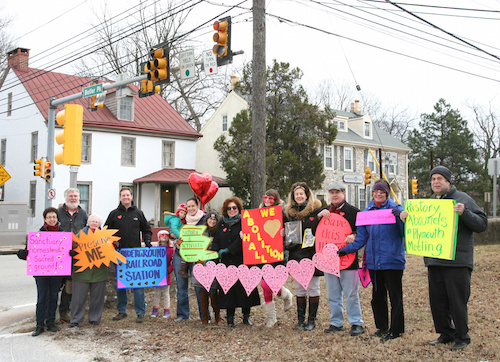
Advocates showing their love for this property in Plymouth Meeting, Montgomery County. Photograph by Vita Litvak.
JEWELERS ROW
702–710 Sansom Street, Philadelphia, Philadelphia County
THREAT: Demolition
Toll Brothers City Living has said it will demolish several buildings in America’s oldest continuously operating diamond district to erect a 29-story luxury residential high-rise.
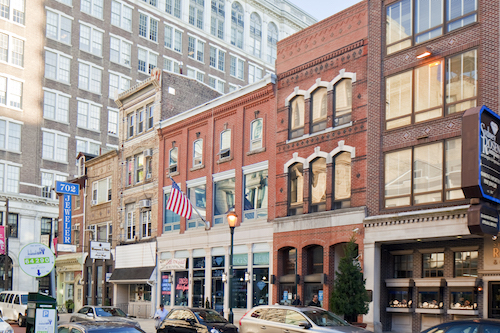
Jeweler’s Row on Sansom Street in Philadelphia. Photograph by Peter Woodall.
MIFFLIN HOUSE
202 Cool Springs Road Wrightsville, Hellam Township, York County
THREAT: Demolition
Jonathan and Susanna Mifflin were pioneers in the Underground Railroad in the 1820s and 1830s. Located just north of Wrightsville on the west bank of the Susquehanna River, the property provided an ideal location to keep fugitive slaves safe until they could be transported across the river to Columbia.
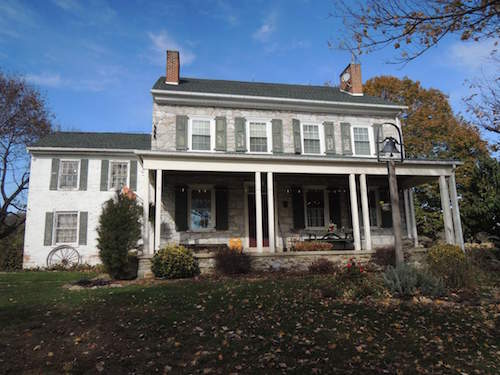
Jonathan and Susan Mifflin House is a former Underground Railroad stop in Hellam Township, York County. Photograph by Randall Harris.
Control Concerns
BUCK’S TAVERN
7590 Jonestown Road, West Hanover Township, Dauphin County
THREAT: Physical Deterioration, Demolition
The oldest part of the property dates between 1730-1750. The newest portion was built in 1805 and served as a tavern for more than a century (the discovery of a box of gold wedding bands in the tavern walls teases the imagination). Owned by the local township, it has no use for the building.
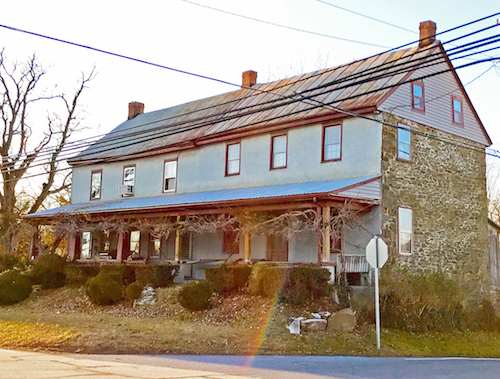
Buck’s Tavern served West Hanover Township, Dauphin County as a tavern for over 100 years. Image courtesy of Preservation Pennsylvania.
HOKE HOUSE
420 N. Main Street, Spring Grove, York County
THREAT: Demolition
The Georgian-style house was built c. 1750, is the oldest building in Spring Grove, and is a contributing resource in the National Register Spring Grove Historic District. Rutter’s Properties owns the adjacent convenience store, but has no use for the historic structure.
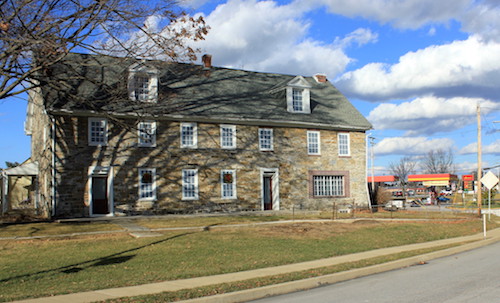
Hoke House was built ca. 1750 and is the oldest surviving building in Spring Grove. Image courtesy of Preservation Pennsylvania.
MOON LORN
357 Parcell Road Prosperity, Morris Township, Washington County
THREAT: Deterioration
A foundation’s unsuccessful effort to use the former home of painter Malcolm Parcell to host visiting artists led to the eventual sale of the 14-acre property to CONSOL Energy Land Resources Division (CNX Land LLC) for longwall coal mining. The unoccupied and remote property is deteriorating and subject to vandalism. Local advocates hope to work with CONSOL to save the property.
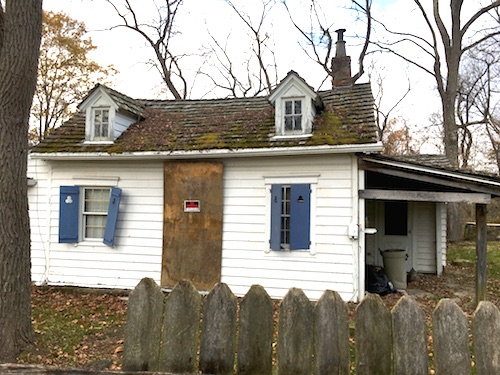
Moon Lorn, the former home of painter Malcolm Parcell in Morris Township, Washington County. Image courtesy of Preservation Pennsylvania.
MEADOWBROOK FARMSTEAD
Campbell Lane, Schuylkill Township, Chester County
THREAT: Demolition
This National Register-listed farmstead dates from 1754 and during the American Revolution it served as both a hospital and a headquarters for American officers. Located just a few miles from the encampment at Valley Forge, the home boasted illustrious visitors such as General Horatio Gates and Benedict Arnold. Since the 1930s it served as a golf club but was recently acquired by eminent domain by the Phoenixville Area School District for potential expansion. A Schuylkill Township task force hopes to find a way to save the farmstead from demolition.
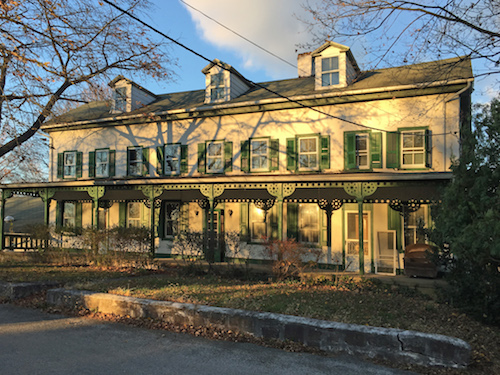
Meadowbrook Farmstead hosted American officers during the American Revolution. Image courtesy of Preservation Pennsylvania.
Local Economy
EKIN HOUSE
203 South Water Street, Elizabeth Borough, Allegheny County
THREAT: Demolition
One of the oldest structures in the borough of Elizabeth, the brick Greek Revival building (c. 1840s) is named for its owner, General James Adams Ekin, a Civil War hero, boat builder, and descendant of the Bayard family, founders of Elizabeth. At the end of the war, Ekin served on the commission that tried the conspirators in President Lincoln’s assassination. The Ekin House needs a new owner and strategy for re- use that could include a commercial venture or return to use as a private residence.
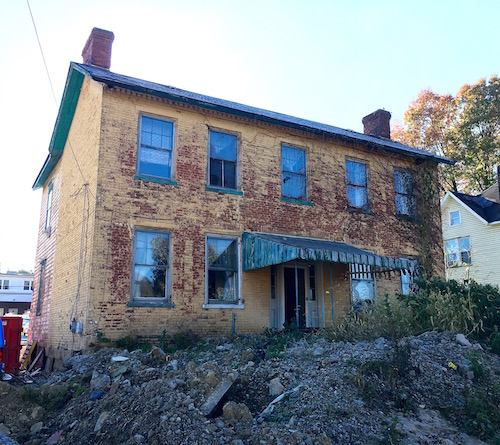
The ca. 1840s Ekin House in Elizabeth, Allegheny County. Image courtesy of Preservation Pennsylvania.
MONESSEN SAVINGS AND TRUST
500 Donner Avenue, Monessen, Westmoreland County
THREAT: Demolition
The Monessen Savings and Trust served the banking and business needs of the City of Monessen from 1905-1926 and stands as a living testament to the industrialists that helped shape Monessen and the Pittsburgh region, with historic ties to nationally-significant industries such as Carnegie Steel and the Pittsburgh and Lake Erie Railroad. The City of Monessen owns the property, and City Council is strongly advocating for demolition. A local advocate created the 500 Donner Project envisioning a nonprofit cafe, music center, and auditorium.
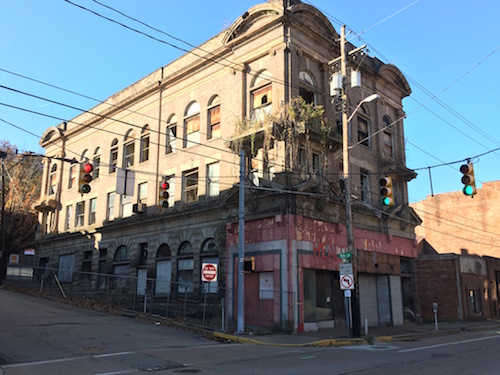
The Monessen Savings and Trust at 500 Donner Avenue in Monessen, Westmoreland County. Image courtesy of Preservation Pennsylvania.
Functional Obsolescence
KIDDIE KLOES FACTORY
West Bertsch Street, Lansford Borough, Carbon County
THREAT: Physical Deterioration
This former silk throwing mill was built in 1904 and is listed as a contributing building in the National Register Lansford Historic District. In 1935, Philadelphia-based Rosenau Brothers, Inc. converted the factory to manufacture their Cinderella brand of girls’ dresses, made famous by child movie star Shirley Temple. The building has been derelict since the 1990s but is now owned by local residents who hope to rehabilitate the building.
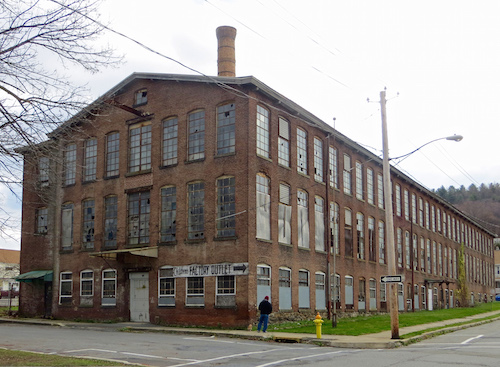
The 1904 Kiddie Kloes factory, known for the popular Cinderella-brand dress in the 1930s and 1940s. Image courtesy of Preservation Pennsylvania.
THE YORKTOWNE HOTEL
East Market Street, York City, York County
THREAT: Partial Demolition
This 198-room hotel opened in downtown York City on October 5, 1925 and has since been the site of most major events in York City. It was purchased by the York County Industrial Development Authority, which closed the hotel in November 2016 for a renovation expected to last two years. Materials distributed by the York County Industrial Development Authority in its search for an architect include the option for partial demolition that would include removal of the top five to seven floors of the building and new construction on top of the base.
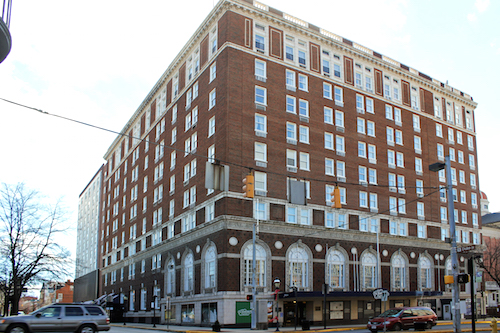
The 1925 Yorktowne Hotel stands as a local landmark in downtown York, York County.
Download the 2017 Pennsylvania At Risk publication at Preservation Pennsylvania’s website. It includes opportunities to get involved and support efforts at the local level.
About Preservation Pennsylvania
Sabra Smith is Communications Director at Preservation Pennsylvania. Preservation Pennsylvania publishes Pennsylvania At Risk annually to draw statewide attention to the plight of Pennsylvania’s historic resources; promote and support local action to protect historic properties; and encourage funding and legislation that supports preservation activities. Helping people to protect and preserve Pennsylvania’s endangered historic properties is a top priority for Preservation Pennsylvania. The organization is committed to engaging with people interested in working to preserve and rehabilitate these significant historic places.
Preservation Pennsylvania is the Commonwealth’s only statewide, private, nonprofit organization dedicated to the protection of historically and architecturally significant resources. For more information, visit the website at www.preservationpa.org or contact Preservation Pennsylvania at 717-234-2310.
Comment Policy
PHMC welcomes and encourages topic-related comments on this blog. PHMC reserves the right to remove comments that in PHMC’s discretion do not follow participation guidelines.
Commenters and Comments shall be related to the blog post topic and respectful of others who use this site.
Commenters and Comments shall not: use language that is offensive, inflammatory or provocative (this includes, but is not limited to, using profanity, obscene, or vulgar comments); disparage other commenters or people; condone illegal activity; identify the location of known or suspected archeological sites; post personal information in comments such as addresses, phone numbers, e-mail addresses or other contact details, which may relate to you or other individuals; impersonate or falsely claim to represent a person or an organization; make any commercial endorsement or promotion of any product, service or publication.
If you would like to comment on other topics not related to this blog post but related to PHMC, please fill out the PHMC Contact Us Form.
What about the Irem temple in Wilkes barre Pennsylvania ?
Holly: The National Register-listed Irem Temple, built 1907-09 in an exotic Moorish design, made the 2013 Pennsylvania At Risk list. ( http://preservationpa.org/uploads/ppa-27-1.pdf – pg. 10) We noted that Harrisburg’s Zembo Shrine was recently listed for sale, indicating a broader trend. These marvelous buildings are a challenge for some to reimagine, but we continue to work to find a new owner/partner with the creative vision to revitalize places like these and return them to community use.
there is a property in Bristol Boro, Bucks County, on the corner of Market and Wood Streets, that is set for demolition in a few months. It is pre revolution and sheltered soldiers during the revolution. Seems the owner let it get worse and really does not care about it at all 🙁
One of the Plymouth Meeting Historic District features is its involvement in Abolition and the Underground Railroad. Geo. Corson held high profile meetings with all of the best Abolitionists. Correspondence related to these activities are documented in the letters of Hannah Wilson from the 1850s. Some of the letters are from Martha Schofield (a Bucks Co. Quaker), another Abolitionist who founded the first all-black boy school in South Carolina. These letters are archived in the Swarthmore University library in the Frederick Collection.
PHMC could further protect this district by including it in its Abolition sites of Pennsylvania.
It’s heartbreaking to think how quickly we can lose pieces of our history if they aren’t prioritized. Each site on the list has its own unique story that deserves preservation, and I appreciate that nominations come directly from the public—it makes me feel more involved in this important cause. Honestly, I plan to visit some of these locations to see firsthand what’s at stake while supporting efforts to save them.